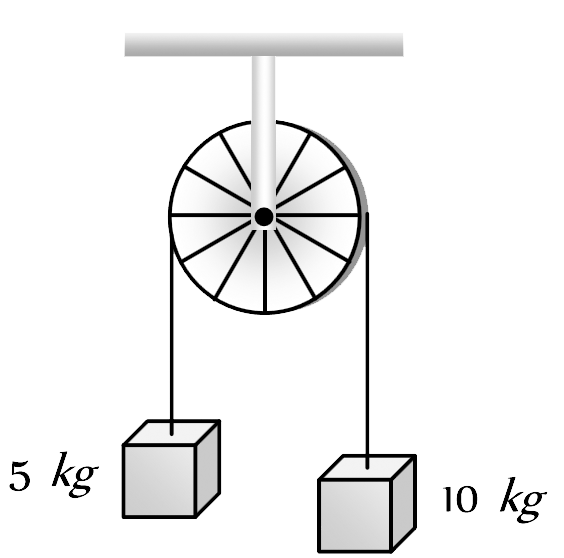A block of 1 kg is stopped against a wall by applying a force F perpendicular to the wall. If then minimum value of F will be Solution in Gujrati
The stituation is shown in fig. The forces acting on the book are For book to be at rest it is essential that
But and

Topper's Solved these Questions
- NEWTONS LAWS OF MOTIONBOOK - ALLEN CHAPTER - NEWTONS LAWS OF MOTIONEXERCISE - EXERCISE-I
52 Videos
- NEWTONS LAWS OF MOTIONBOOK - ALLEN CHAPTER - NEWTONS LAWS OF MOTIONEXERCISE - EXERCISE-II
112 Videos
- NEWTONS LAWS OF MOTIONBOOK - ALLEN CHAPTER - NEWTONS LAWS OF MOTIONEXERCISE - EXERCISE-III
28 Videos
- NEWTON'S LAWS OF MOTION & FRICTIONBOOK - ALLEN CHAPTER - NEWTON'S LAWS OF MOTION & FRICTIONEXERCISE - EXERCISE (JA)
4 Videos
- RACEBOOK - ALLEN CHAPTER - RACEEXERCISE - Basic Maths (Wave Motion & Dopplers Effect) (Stationary waves & doppler effect, beats)
25 Videos
Similar Questions
USS 150) Two masses of 5 kg and 10 kg are connected to a pulley as shown. What will be the acceleration of the system (g= acceleration due to gravity)

View SolutionA particle is in straight line motion with uniform velocity A force is not required
View SolutionAssertion: The driver in a vechicle moving with a constant speed on a straight road is in a non-inertial frame of referance.
Reason: A reference frame in which Newton's laws of motion are applicable is non-inertial.
View SolutionA piece of wire is bent in the shape of a parabola y=kx2 (y-axis vertical) with a bead of mass m on it. The bead can slide on the wire without friction. It stays at the lowest point of the parabola when the wire is at rest. The wire is now accelerated parallel to the x-axis with a constant acceleration a. The distance of the new equilibrium position of the bead, where the bead can stay at rest with respect to the wire, from the y-axis is:
View SolutionThe frequency of a radar is 780 MHz. After getting reflected from an approaching aeroplane, the apparent frequency is more than the actual frequency by 2.6 kHz. The aeroplane has a speed of
View SolutionA block weighs W is held against a vertical wall by applying a horizontal force F. The minimum value of F needed to hold the block is
View SolutionMinimum force required to keep a block of mass 1 kg at rest against a rough vertical wall is P. If a force P/2 is applied then the acceleration of the block will be :

View SolutionA rectangular block of mass 6 kg is to be held against a rough vertical wall by appplying a force perpendicular to the wall. What is the minimum force to be applied, if the coefficient of friction is 0.42?
View SolutionA rectangular block of mass 2 kg is to be held against a rough vertical wall by applying a force of 98 N perpendicular to the wall. What is the coefficients of friction if the applied force is the minimum required force?
View SolutionAn object of mass m held against a vertical wall by applying horizontal force F as shown in the figure . The minimum value of the force F is
View SolutionA block of mass 1 kg is pushed against a rough vertical wall of μ=0.1

For F = 150, 50 or 100 N the force of friction on the blocks is respectively :
View Solutionएक 1 किलोग्राम के पिंड को एक दीवार के लंबवत बल F लगाकर दीवार के साथ रोके रखा गया हैं | यदि घर्षण गुणांक μ=0.2 हैं, तो बल f का न्यूनतम मान हैं-
View SolutionA block of mass 10 kg is held at rest against a rough vertical wall [mu=0.5] under the action a force F as shown in figure. The minimum value of F required for it is (g=10m//s^(2))
View SolutionAn object of mass m held against a vertical wall by applying horizonatal force F as the minimum of the force is

View SolutionA homogeneous block rests against a vertical wall for which the coefficient of friction is 1//2 . A force 'F' is applied to the block in the direction as shown in figure. Find the maximum magnitude of applied force 'F' such that block remains in rest.
View SolutionA man manages to balance a block of mass 2 kg by pushing it in horizontal against an erect wall. If mu= 0.25 between the wall and the block , and mu = 0.15 between the block and the hand, find the force needed to be applied by the man.
View Solution
